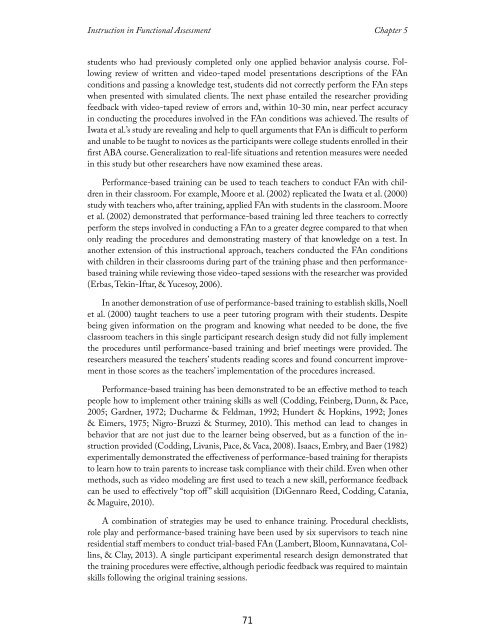Instruction in Functional Assessment, 2014a
Instruction in Functional Assessment, 2014a
Instruction in Functional Assessment, 2014a
You also want an ePaper? Increase the reach of your titles
YUMPU automatically turns print PDFs into web optimized ePapers that Google loves.
<strong>Instruction</strong> <strong>in</strong> <strong>Functional</strong> <strong>Assessment</strong> Chapter 5<br />
students who had previously completed only one applied behavior analysis course. Follow<strong>in</strong>g<br />
review of written and video-taped model presentations descriptions of the FAn<br />
conditions and pass<strong>in</strong>g a knowledge test, students did not correctly perform the FAn steps<br />
when presented with simulated clients. The next phase entailed the researcher provid<strong>in</strong>g<br />
feedback with video-taped review of errors and, with<strong>in</strong> 10-30 m<strong>in</strong>, near perfect accuracy<br />
<strong>in</strong> conduct<strong>in</strong>g the procedures <strong>in</strong>volved <strong>in</strong> the FAn conditions was achieved. The results of<br />
Iwata et al.’s study are reveal<strong>in</strong>g and help to quell arguments that FAn is difficult to perform<br />
and unable to be taught to novices as the participants were college students enrolled <strong>in</strong> their<br />
first ABA course. Generalization to real-life situations and retention measures were needed<br />
<strong>in</strong> this study but other researchers have now exam<strong>in</strong>ed these areas.<br />
Performance-based tra<strong>in</strong><strong>in</strong>g can be used to teach teachers to conduct FAn with children<br />
<strong>in</strong> their classroom. For example, Moore et al. (2002) replicated the Iwata et al. (2000)<br />
study with teachers who, after tra<strong>in</strong><strong>in</strong>g, applied FAn with students <strong>in</strong> the classroom. Moore<br />
et al. (2002) demonstrated that performance-based tra<strong>in</strong><strong>in</strong>g led three teachers to correctly<br />
perform the steps <strong>in</strong>volved <strong>in</strong> conduct<strong>in</strong>g a FAn to a greater degree compared to that when<br />
only read<strong>in</strong>g the procedures and demonstrat<strong>in</strong>g mastery of that knowledge on a test. In<br />
another extension of this <strong>in</strong>structional approach, teachers conducted the FAn conditions<br />
with children <strong>in</strong> their classrooms dur<strong>in</strong>g part of the tra<strong>in</strong><strong>in</strong>g phase and then performancebased<br />
tra<strong>in</strong><strong>in</strong>g while review<strong>in</strong>g those video-taped sessions with the researcher was provided<br />
(Erbas, Tek<strong>in</strong>-Iftar, & Yucesoy, 2006).<br />
In another demonstration of use of performance-based tra<strong>in</strong><strong>in</strong>g to establish skills, Noell<br />
et al. (2000) taught teachers to use a peer tutor<strong>in</strong>g program with their students. Despite<br />
be<strong>in</strong>g given <strong>in</strong>formation on the program and know<strong>in</strong>g what needed to be done, the five<br />
classroom teachers <strong>in</strong> this s<strong>in</strong>gle participant research design study did not fully implement<br />
the procedures until performance-based tra<strong>in</strong><strong>in</strong>g and brief meet<strong>in</strong>gs were provided. The<br />
researchers measured the teachers’ students read<strong>in</strong>g scores and found concurrent improvement<br />
<strong>in</strong> those scores as the teachers’ implementation of the procedures <strong>in</strong>creased.<br />
Performance-based tra<strong>in</strong><strong>in</strong>g has been demonstrated to be an effective method to teach<br />
people how to implement other tra<strong>in</strong><strong>in</strong>g skills as well (Codd<strong>in</strong>g, Fe<strong>in</strong>berg, Dunn, & Pace,<br />
2005; Gardner, 1972; Ducharme & Feldman, 1992; Hundert & Hopk<strong>in</strong>s, 1992; Jones<br />
& Eimers, 1975; Nigro-Bruzzi & Sturmey, 2010). This method can lead to changes <strong>in</strong><br />
behavior that are not just due to the learner be<strong>in</strong>g observed, but as a function of the <strong>in</strong>struction<br />
provided (Codd<strong>in</strong>g, Livanis, Pace, & Vaca, 2008). Isaacs, Embry, and Baer (1982)<br />
experimentally demonstrated the effectiveness of performance-based tra<strong>in</strong><strong>in</strong>g for therapists<br />
to learn how to tra<strong>in</strong> parents to <strong>in</strong>crease task compliance with their child. Even when other<br />
methods, such as video model<strong>in</strong>g are first used to teach a new skill, performance feedback<br />
can be used to effectively “top off ” skill acquisition (DiGennaro Reed, Codd<strong>in</strong>g, Catania,<br />
& Maguire, 2010).<br />
A comb<strong>in</strong>ation of strategies may be used to enhance tra<strong>in</strong><strong>in</strong>g. Procedural checklists,<br />
role play and performance-based tra<strong>in</strong><strong>in</strong>g have been used by six supervisors to teach n<strong>in</strong>e<br />
residential staff members to conduct trial-based FAn (Lambert, Bloom, Kunnavatana, Coll<strong>in</strong>s,<br />
& Clay, 2013). A s<strong>in</strong>gle participant experimental research design demonstrated that<br />
the tra<strong>in</strong><strong>in</strong>g procedures were effective, although periodic feedback was required to ma<strong>in</strong>ta<strong>in</strong><br />
skills follow<strong>in</strong>g the orig<strong>in</strong>al tra<strong>in</strong><strong>in</strong>g sessions.<br />
71


















